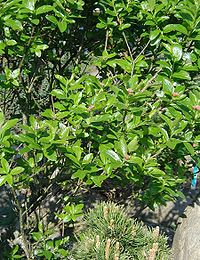False Medlar
| Sorbus chamaemespilus subsp. var. | False Medlar, Dwarf whitebeam | |||||||||||||||||||||||||||||||||||||||||||||||||||||||
|---|---|---|---|---|---|---|---|---|---|---|---|---|---|---|---|---|---|---|---|---|---|---|---|---|---|---|---|---|---|---|---|---|---|---|---|---|---|---|---|---|---|---|---|---|---|---|---|---|---|---|---|---|---|---|---|---|

|
|
| ||||||||||||||||||||||||||||||||||||||||||||||||||||||
| ||||||||||||||||||||||||||||||||||||||||||||||||||||||||
Sorbus chamaemespilus (False Medlar or Dwarf Whitebeam) is a species of Sorbus native to the mountains of central and southern Europe, from the Pyrenees east through the Alps to the Carpathians and the Balkans, growing at altitudes of up to 2500 m.[1]
It is a deciduous shrub growing to 2–3 m tall. The leaves are spirally arranged, oval-elliptic, 3-7 cm long, with an acute apex and a serrated margin; they are green on both sides, without the white felting found on most whitebeams. The flowers are pink, with five forward-pointing petals 5-7 mm long; they are produced in corymbs 3-4 cm diameter. The fruit is an oval red pome 10-13 mm diameter.[1][2]
It is the sole species in the subgenus Chamaemespilus, distinguished from other subgenera of Sorbus by the pink (not white) flowers with the forward-pointing petals (not opening flat).[2]
Cultivation
Propagation
Pests and diseases
Varieties
Gallery
References
- ↑ 1.0 1.1 Blamey, M. & Grey-Wilson, C. (1989). Flora of Britain and Northern Europe. ISBN 0-340-40170-2
- ↑ 2.0 2.1 Rushforth, K. (1999). Trees of Britain and Europe. Collins ISBN 0-00-220013-9.
External links
- w:False Medlar. Some of the material on this page may be from Wikipedia, under the Creative Commons license.
- False Medlar QR Code (Size 50, 100, 200, 500)

